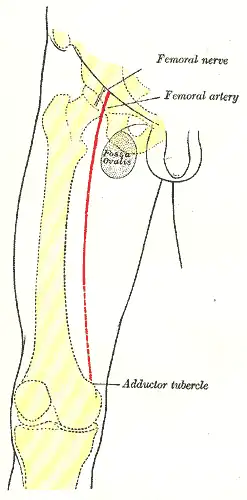Duroziez's sign
| Duroziez's sign | |
|---|---|
| Other names: Alvarenga-Duroziez sign | |
 | |
| Femoral artery | |
| Differential diagnosis | Aortic insufficiency |
Duroziez's sign is a sign of aortic insufficiency.[1][2] It consists of an audible diastolic murmur which can be heard over the femoral artery when it is compressed with the bell of a stethoscope.[3]
It is named for French physician Paul Louis Duroziez who published its description in 1861,[4][5] even though it was first described by Portuguese physician Pedro Francisco da Costa Alvarenga in 1855;[6] for this reason it is alternatively known as the Alvarenga-Duroziez sign.
References
- ↑ Kawamata, Hirofumi; Yamano, Michiyo; Kawasaki, Tatsuya. "Duroziez's Sign". Circulation Reports. 2 (7): 380–381. doi:10.1253/circrep.CR-20-0029. ISSN 2434-0790. PMID 33693257. Archived from the original on 2022-11-11. Retrieved 2022-11-06.
- ↑ Babu AN, Kymes SM, Carpenter Fryer SM (May 2003). "Eponyms and the diagnosis of aortic regurgitation: what says the evidence?". Ann. Intern. Med. 138 (9): 736–42. doi:10.7326/0003-4819-138-9-200305060-00010. PMID 12729428.
- ↑ Huon H Gray et al., "Examination of the Head and Neck, Chapter 2: The Cardiovascular system, Lecture Notes on Cardiology, 4th Edtn, Blackwell Publishing, Oxford 2002
- ↑ synd/2737 at Who Named It?
- ↑ P. L. Duroziez. Du double souffle intermittent crural, comme signe de l’insuffisance aortique. Archives générales de médecine, Paris, 1861, 5 sér., 17: 417-443, 588-605.
- ↑ Alvarenga, Pedro Francisco da Costa (1856). Mémoire sur l'insuffisance des valvules aortiques et considérations générales sur les maladies du cœur (in French). Paris: Chez J.-B. Baillière.
{{cite book}}: CS1 maint: unrecognized language (link)
This article is issued from Offline. The text is licensed under Creative Commons - Attribution - Sharealike. Additional terms may apply for the media files.